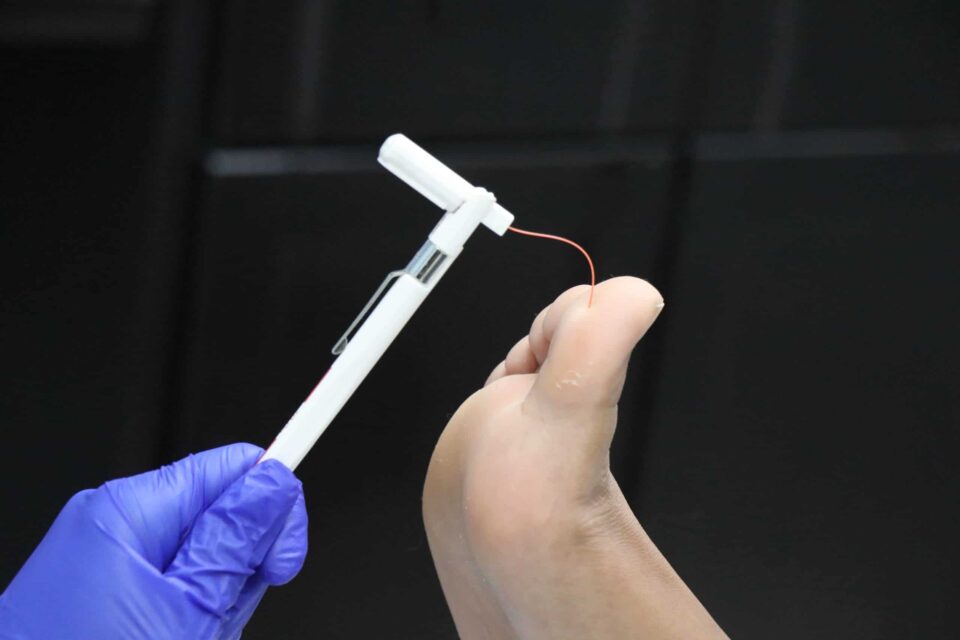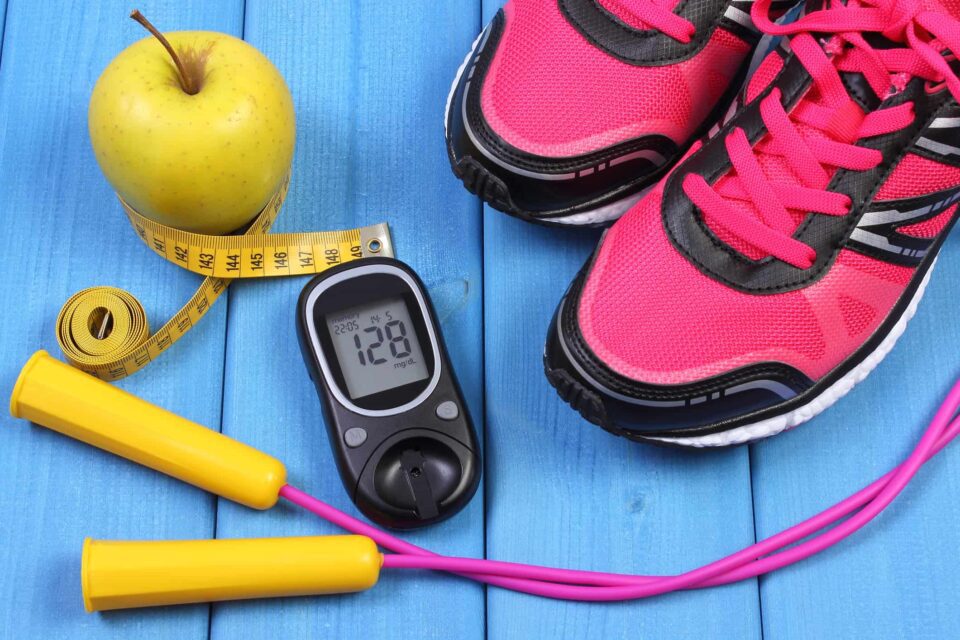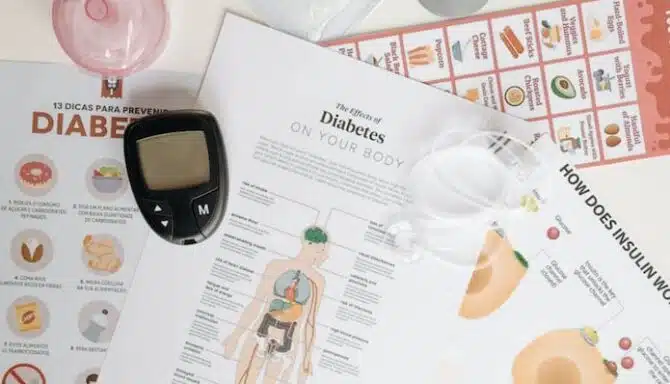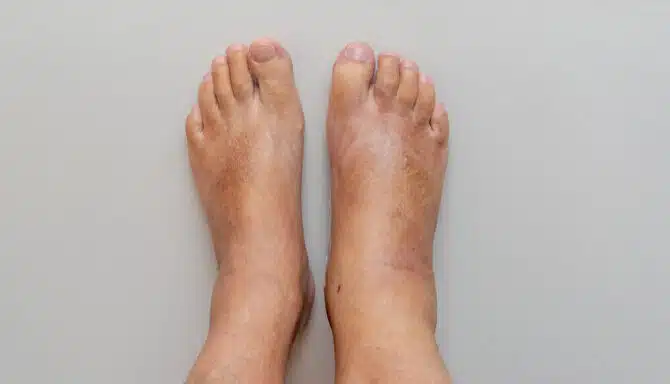October 16, 2025
Diabetes is a chronic condition that affects many parts of the body, including your feet and toenails. Proper foot care is especially important for people with diabetes because they are at a higher risk of developing complications that can impact mobility and overall health. Understanding how diabetes affects toenails can help you prevent problems and maintain healthy feet.
Why Diabetes Impacts Toenail Health
People with diabetes often experience poor circulation and nerve damage (neuropathy) in their feet. These issues make it harder for wounds and infections to heal and can reduce sensation, so small injuries or infections may go unnoticed. Toenails can also become more vulnerable to damage, infections, and deformities.
Common Toenail Problems in People with Diabetes
1. Fungal Infections
Diabetes can weaken the immune system, making it easier for fungal infections like athlete’s foot or toenail fungus to develop. Fungal toenails may become thickened, discolored, brittle, and painful.
In addition, good circulation is required for the natural moisturization processes in the toenails and feet. Diabetes disrupts blood flow to the feet, which means they can't properly moisturize themselves. This dries out the toenails and causes them to become brittle. It also dries out the skin, which can cause small cracks and abrasions. Fungus can then more easily penetrate through brittle cracked toenails and abrasions. Once it does, it's harder for your body to fight the infection due to diabetes' affect on the immune system.
2. Ingrown Toenails
Reduced sensation means small cuts or ingrown toenails might not be felt immediately, increasing the risk of infection. Ingrown toenails can cause redness, swelling, and pain if left untreated.
3. Toenail Discoloration and Deformities
Poor circulation and infections may cause toenails to change color, thicken, or become deformed. This is because circulation is required to facilitate the toenail growth process. When this process is disrupted, it causes nail cells to build up on top of each other rather than beside each other, which causes thickening and an irregular toenail shape. This can make nail trimming difficult and increase the risk of injury.
4. Delayed Healing
Any cuts or injuries around the toenails heal more slowly in people with diabetes, increasing the chance of complications like ulcers or infections.
Tips for Preventing Toenail Problems with Diabetes
Practice Good Foot Hygiene
Wash your feet daily with warm water and mild soap.
Dry your feet thoroughly, especially between the toes.
Keep Toenails Trimmed and Clean
Cut nails straight across to prevent ingrown toenails.
Avoid cutting nails too short or rounding the corners.
Wear Proper Footwear
Choose shoes with a wide toe box and good support.
Avoid tight or narrow shoes that can cause pressure and injury.
Regular Foot and Toenail Checks
Inspect your feet daily for cuts, blisters, redness, or swelling.
Have a healthcare professional, like a chiropodist, examine your feet regularly.
Manage Blood Sugar Levels
Keeping blood glucose under control supports overall foot health and healing.
When to See a Foot Specialist
It is recommended that people with diabetes include a chiropodist in their healthcare team and see them on a routine, ongoing basis for diabetic foot care. When it comes to diabetes, prevention is the best treatment.
If you notice any signs of infection, persistent pain, changes in nail appearance, or wounds that don’t heal, it’s essential to seek professional care promptly. Early intervention can prevent serious complications, including foot ulcers and infections that may lead to amputation.
March 20, 2025
Ram’s horn toenails? Sounds like a serious foot issue! And it is—this condition, medically known as onychogryphosis, causes thickened, curved nails that can become painful and difficult to manage over time. It doesn’t just affect nail appearance; it can lead to discomfort, infection, and mobility issues if left untreated. Fortunately, onychogryphosis treatment options from a chiropodist or podiatrist are available to help you manage comfort and nail health.
What Are Ram’s Horn Toenails?
View this post on Instagram A post shared by Feet First Clinic (@feetfirstclinic_)
Ram’s horn toenails (onychogryphosis), one of the many types of toenail conditions, is classified as a nail disorder or nail disease where the toenail becomes extremely thick, abnormally curved, and overgrown, often resembling the spiraled shape of a ram’s horn. This happens because the nail plate—made of keratin—grows unevenly due to disruptions in the nail matrix, the part of the nail bed responsible for new cell production. Instead of growing outward smoothly, the nail thickens, hardens, and may curl or twist due to uneven pressure and irregular cell turnover. They have a similar appearance to a severe fungal toenail infection.
The texture of a ram’s horn toenail is usually rough, ridged, and extremely hard, making it difficult to trim with standard nail clippers. Over time, the nail can develop a yellowish, brownish, or even grayish hue due to keratin buildup and potential fungal infections. In severe cases, the nail may grow so long and misshapen that it presses into the surrounding skin, causing pain, tenderness, and difficulty wearing shoes or walking comfortably. Because the thickened nail loses its normal flexibility, it can crack or split, increasing the risk of infection.
The appearance of onychogryphosis can also affect confidence and make it difficult to find shoes that accommodate their size and abnormal shape.
Although onychogryphosis most commonly affects the big toe, it can develop on others as well. It tends to progress gradually, meaning that early signs—such as mild thickening or slight discoloration—can go unnoticed until the nail has significantly changed in shape and texture.
Causes of Ram’s Horn Toenails
https://www.youtube.com/shorts/3JAUqiqJfus
These toenails do not generally form spontaneously without an underlying cause or risk factor. Let’s take a look at what generally causes this nail disorder.
Risk Factors for Ram’s Horn Toenails:
Trauma and Ill-Fitting Footwear
Repeated or acute trauma to the toenail can disrupt normal nail growth, leading to thickening and deformation. Continuous pressure and friction, such as from ill-fitting footwear, can cause microtrauma to the nail bed, contributing to the development of onychogryphosis. Essentially, the toenail thickens and starts growing in a different direction to protect itself.
Age
In general, our feet become more vulnerable with age due to several physiological changes that can occur, which can predispose us to onychogryphosis. For instance, reduced peripheral circulation, common in older adults, impairs blood flow to the extremities, leading to diminished oxygen and nutrient delivery to the nails. This alters the nail's natural growth process, causing nails to grow slower and nail cells to pile up on top of each other (rather than growing out). As a result, they thicken and can change shape. Additionally, decreased mobility in the elderly may lead to inadequate foot care, contributing to nail abnormalities.
https://www.youtube.com/shorts/gEi59gq5g54
Diabetes
Diabetes significantly increases the risk of developing onychogryphosis, particularly due to the effects of diabetic neuropathy. Diabetic peripheral neuropathy reduces sensation in the feet, so individuals may not notice pressure, injuries, or trauma to the toenails, which can lead to deformities like onychogryphosis. Without the ability to feel discomfort, they may unintentionally cause damage to the nail, leading to thickening, curling, and other changes associated with the condition. Additionally, poor circulation caused by diabetes can impede healthy nail growth, making the nails more prone to abnormalities.
Peripheral Vascular Disease (PVD)
As already discussed, poor circulation affects the nail growth process and can lead to nail deformities. In particular, peripheral vascular disease involves the narrowing of peripheral arteries, reducing blood flow to the limbs. The diminished circulation can cause various symptoms, including slow or unusual nail growth. Without proper blood flow, the nails may become thickened and misshapen, potentially progressing to onychogryphosis if left untreated.
Cognitive Impairment
Relating back to age as a risk factor, conditions such as dementia can lead to neglected foot care due to cognitive decline. Individuals with dementia may forget or be unable to perform regular foot hygiene practices, increasing the risk of nail deformities like onychogryphosis. Self neglect, or infrequent cutting of toenails for a significant amount for any reason, is also a risk factor.
High-Friction Sports and Activity
Participating in high-friction sports like running, soccer, or ballet can increase the risk of developing onychogryphosis. Repetitive pressure and friction from constant movement or improper footwear during these activities can cause trauma to the toenail, leading to thickening, curling, and potential deformity. Runners, for example, often experience repeated impact on their toenails, particularly the big toe, which can cause them to become damaged or misshapen over time. Additionally, athletes who wear shoes that are too tight or too loose, which cause friction and rubbing, are more likely to develop toenail issues. As is the case with ill-fitting footwear, over time, the nail thickens and changes growth direction in order to protect itself from the repetitive trauma.
Hyperuricemia
High levels of uric acid in the blood is often associated with gout, but it can also contribute to the development of onychogryphosis. Elevated uric acid can lead to the deposition of urate crystals in joints and tissues, including the nails, which can cause inflammation and damage. This buildup may result in nail thickening, distortion, and a rough appearance. While gout primarily affects joints, the condition’s systemic nature can also have an impact on nail health
Fungal Infections
Also known as onychomycosis, fungal infections cause thickening and nail distortion. These infections often thrive in warm, moist environments and can infiltrate the nail, leading to changes in color, texture, and shape. In diabetic patients, onychomycosis prevalence is notably higher, reaching up to 31.5%, due to factors like elevated blood glucose levels and compromised immune response.
Psoriasis / Psoriatic Arthritis
Psoriasis or psoriatic arthritis can cause nail changes in roughly half of affected individuals. Proper management of psoriasis through medical treatments can help alleviate these nail changes and improve overall nail health.
Treating Ram’s Horn Toenails: Nail Care for Curved Toenails
https://www.youtube.com/shorts/QFWBwM6mGqM
Routine Professional Nail Care
It’s very important to visit a Podiatrist or Chiropodist, both types of foot specialists in Ontario, if you have Ram’s horn toenails. This is because it is far too difficult, even dangerous, to manage them yourself. Their thickness, abnormal shape and unsightly appearance and positioning on your foot make it impractical to try cutting them with standard nail clippers, and is not advised.
A chiropodist or podiatrist can tend to your nails properly with specialized tools designed to maintain nail disorders. They can also perform toenail debridement, smooth out nail edges, clean out debris, and apply sprays that help with discoloration.
Other nail care treatment options may vary depending on the severity of the condition. In more extreme cases, surgical interventions such as nail avulsion—removal of the nail plate—may be considered.
If an infection is present, a chiropodist or podiatrist can prescribe the appropriate antifungal or antibacterial treatments to address the underlying cause (you can't treat fungal infections from home).
In addition to the specialized care provided by podiatrists and chiropodists, treatment for Ram’s horn toenails can also include regular monitoring to track any changes in the condition. They may suggest specific at-home care practices, such as gentle cleaning and moisturizing, to support the overall health of the nails and surrounding skin. For individuals with chronic conditions, like diabetes, it is especially important to maintain close contact with a foot care specialist to ensure the toenails remain manageable and complications are avoided. Diabetes patients who neglect their foot health can experience severe ulcer formation.
Onyfix
Onyfix is just one of the many unique ways a foot specialist can help treat curved, curled or Ram's Horn Toenails. It's a non-surgical treatment that involves the placement of a band across the toenail. This band then corrects the nail's growth pattern and shape. It's great for Ram's Horn Toenails because it will help flatten out the toenail on the nail bed and "train" the toenail to grow in the correct direction.
Proper Fitting Footwear
But all the treatment in the world won't matter without eliminating one of the most common causes of curved, curled and abnormal toenails: ill-fitting footwear. As we already discussed, ill-fitting footwear causes repetitive trauma on the nailbed, which disrupts the toenail's growth process. Prioritizing footwear that minimizes pressure and allows for adequate toe room to alleviate discomfort and prevent further nail distortion is key. Opting for shoes with a wide toe box provides ample space for the toes to spread naturally, reducing friction and pressure on the affected nails. Shoes may also require extra depth, and orthopedic footwear may be required for sufficient comfort.
Featured Photo By PixaBay
December 5, 2024
Seasonal changes can significantly impact diabetic foot health. In the summer, heat and sweating can create challenges, while cold temperatures and wet weather during the winter present other risks. That's why diabetic winter foot care is so important. Today we'll talk about:
You'll learn all about:
The connection between diabetes and foot health
The importance of diabetic foot care in the winter
Our Foot Specialists' top tips for diabetic winter foot care
The Connection Between Diabetes and Foot Health
https://www.youtube.com/shorts/4P3UiDSFzr4
Approximately 800 million adults worldwide have diabetes. It isn’t often immediately recognized as a foot condition on its own, but a serious issue called diabetic foot (a broad term encompassing a wide range of problems) can occur. As a result, foot care should be a top health priority for people with diabetes.
Reduced Blood Flow
People with Diabetes are at risk of developing neuropathy. There are four types, with peripheral symmetric neuropathy (which affects the feet and hands) being the most relevant for diabetes patients.
This condition develops when elevated glucose levels lead to a series of metabolic and vascular changes that impair nerve function. Over time, excess glucose triggers oxidative stress and inflammation, damaging the small blood vessels (microvasculature) that supply the nerves. Without adequate blood flow, nerves are deprived of oxygen and essential nutrients, resulting in their gradual deterioration.
Reduced Sensation
This damage primarily affects sensory nerves, which are responsible for transmitting pain, temperature, and pressure signals to the brain. This progressive loss of sensation makes it difficult for individuals to detect injuries or changes in their feet, such as cuts, blisters, or pressure points. These minor skin issues can turn to diabetic ulcers (open sores or wounds) when ignored.
Reduced Immune Function
Diabetes can also contribute to ulcer formation due to its impact on the immune system. High blood sugar levels over time impair the function of white blood cells, which are essential for fighting infections and promoting wound healing. When blood glucose levels are consistently elevated, it reduces the ability of these immune cells to properly respond to bacteria or other pathogens. This makes it more difficult for the body to prevent wounds that may develop on the feet - including minor cuts, blisters, pressure sores or even calluses - from getting infected. As a result, these small injuries are more likely to become infected, and ultimately lead to diabetic ulcers.
The impaired immune function, combined with poor circulation and reduced sensation, creates a perfect environment for these infections and ulcers to progress, further delaying healing and increasing the risk of severe complications, such as deep tissue infections or gangrene.
Why is Diabetic Foot Care Important in the Winter?
Cold and wet weather can impact everyone's feet, but winter can have a more severe effect on people with diabetes.
Cold Weather and Diabetes: Risk Factors
Low temperatures: Cold air can reduce circulation by constricting blood vessels, particularly in the lower extremities, making it even more difficult for already-compromised vessels to supply the feet with sufficient oxygen and nutrients. This further impairs the body’s ability to heal wounds.
Wet conditions: Snow, rain and sleet getting into your shoes and socks is a recipe for disaster for diabetics. You can develop blisters, sores and infections (which are all ulcer risks) when you let moisture build for too long.
Dry skin: On the other hand, it is also not ideal for your skin to be too dry. By nature, cold air is very dry. Indoor heating makes the air even dryer by extracting humidity. The lack of moisture in the air dries out the skin - including the skin on our feet. This makes calluses form faster and can lead to issues like cracked heels. And since diabetes impairs the body's ability to heal dry skin and cracked heels, the cracks can easily split open, get infected and turn into a diabetic ulcer.
Winter Foot Care for Diabetics
Podiatrists and chiropodists strongly advise individuals with diabetes to take extra care of their feet during the winter months due to the increased risks posed by the elements. If you have diabetes, keep reading to learn the best tips for winter foot care - all recommended by the foot specialists at our Toronto foot clinic.
Practice Skin Care
https://www.youtube.com/shorts/1-Sf43woLLE
Moisturizing your feet regularly is one of the most important steps to combat dry, cracked skin. However, our foot specialists also caution against using harsh creams full of chemicals and fragrances - especially if you have diabetes. Opt for medically respected products with natural ingredients, like Gehwol’s Lipidro and Dermal Therapy Heel Care, that replenish the natural amount of moisture in the skin while also healing cracks.
Only moisturize your feet after thoroughly cleaning and drying. Check out this ultimate guide to moisturizing your feet to master four easy steps. While you're at it, check out the best foot hygiene routine.
Perform Foot Stretches and Exercises
Movement is one of the most effective ways to manage diabetic foot concerns and counteract the impact of cold weather on blood flow. Low-impact cardio exercises such as swimming and walking can assist people in managing blood flow and sensation loss, respectively. Removing the elements of competition and high strain exertion found in other sports, and focusing solely on safety and motion, is a great way to encourage activity.
There are also targeted, low-impact and easy-to-perform foot stretches and exercises designed for people with diabetes. The goal is to stimulate blood circulation as much as possible while still considering any physical limitations. Below are three light exercises you can try from home, and while they may be hard to perform at first, practice makes perfect!
Toe Curls: Sit with your back straight, feet planted, and use a towel to scrunch your toes and pull it toward you, repeating five times per foot.
Figure Eights: Lift one foot while keeping the heel on the floor, move your foot in a "figure eight" motion, repeating five to 10 times per foot in each direction.
Single Leg Lifts: Stand with feet shoulder-width apart, hands on hips, and lift your left foot straight out in front, keeping your leg straight and foot flexed, repeating five times per foot.
To learn more about these exercises, check out the best stretches and exercises for diabetes.
Practice Moisture Control
Keep your feet reasonably dry as much as possible. This may mean changing your socks and shoes several times per day, and thoroughly drying your feet with a towel intermittently. While this can be annoying and easy to forget during the busy winter season, it’s important to stay on top of this with snow, sleet and rain posing an extra risk.
It’s important to not go overboard with too much direct heat penetrating your feet. While cozying up by the fire is safe on occasion, excessive heat can cause even more damage to the nerves. This is due to reduced sensation in diabetic individuals, which makes it harder to notice high heat and burns.
Below are the best ways to manage excessive moisture during the winter:
Wear moisture-wicking socks.
Change socks regularly, especially if they get wet.
Use foot powders and deodorants.
Choose breathable, well-ventilated shoes.
Choose shoes made with waterproof fabrics, like GORE-TEX. This fabric uses a membrane with pores small enough to block water but large enough to allow sweat vapor to escape. This creates a waterproof yet breathable barrier, keeping feet dry and comfortable.
Dry feet thoroughly with a towel after washing, especially between toes.
Avoid tight shoes that trap moisture.
Consider insoles with moisture-absorbing qualities.
Keep feet clean and dry before bed.
Perform Foot Inspections
At-home foot inspections are a good diabetic foot care measure in the winter (and in general) because they help identify potential issues like cuts, blisters, or signs of infection early, when they're easier to treat.
Check for cuts, blisters, or sores: Examine the entire surface of your feet for any visible signs of injury and skin perforation.
Look for changes in skin color or temperature: Check for any redness, swelling, or areas that feel unusually warm or cold.
Check your toenails and between toes: Look for ingrown toenails, cracked toenails and fungal infections,
Try Diabetic Socks
Compression stockings are a great way to enhance blood flow to the legs and feet, but they are not recommended for people with diabetes since they can do the opposite and restrict blood flow too much in the arteries. Instead, ask a podiatrist or chiropodist about diabetic socks and if they might work for you. They have several benefits, which are especially useful in the winter, including:
Antimicrobial treatment which prevents bacterial and fungal growth.
Slightly cushioned footbed for extra comfort and protection.
Loose, non-binding top band which rests comfortably around the ankles or calves, allowing more circulation.
Moisture-wicking and stretchy material.
Smooth toe area to prevent blisters and other skin irritation.
Choose the Right Footwear
https://www.youtube.com/shorts/R7GV0GbKhvQ
For diabetes patients, wearing proper footwear in the winter is essential for maintaining foot health.
Orthopedic shoes are an excellent choice, as they offer extra cushioning, arch support, depth, elasticity, adjustable straps and ample room to reduce pressure points and prevent blisters or sores.
High-quality winter footwear can also be effective, provided it offers warmth, water resistance, and moisture control properties to keep feet dry and comfortable. Here is what you should pay attention to:
Waterproof materials: As you already know, materials like GORE-TEX help maintain dryness by utilizing a membrane with microscopic pores. These pores are small enough to block water molecules, but large enough to allow vapor from sweat to escape. This technology effectively prevents external moisture, like snow or rain, from penetrating the footwear, keeping feet dry. The breathability of GORE-TEX also ensures that perspiration from the feet can escape, which prevents a buildup of moisture inside the shoe. This combination of waterproofing and breathability is essential for preventing cold and damp feet
Adequate insulation: This is crucial for maintaining warmth in winter footwear as insulation helps lock in warm air and retain body heat. Look for insulated winter shoes and boots that also let you maintain moisture control. And remember to let your feet air out after sweating in your boots all day to avoid excessive dampness.
Non-slip soles: For better traction on icy or slippery surfaces to avoid falls.
Cushioning and arch support: To provide comfort and reduce strain on the feet, especially when walking for extended periods.
Roomy toe box: To avoid friction and pressure on the toes, preventing blisters or sores.
Breathable lining: To allow moisture to escape and keep feet dry, reducing the risk of infections.
Adjustable closures: To ensure a secure fit without restricting circulation, particularly important for those with swelling or neuropathy.
In addition, custom orthotics can provide personalized support, improving foot alignment and alleviating pressure, further reducing the risk of diabetic foot complications.
Visit a Foot Specialist
https://www.youtube.com/shorts/qR3s05lUwyc
Our top tip for managing diabetic feet in winter? Book an appointment with a foot care provider, like a podiatrist or chiropodist, at a foot clinic.
At Feet First Clinic, our chiropodists are trained to:
Offer comprehensive education on how cold weather can affect diabetic feet.
Provide skin and nail care.
Provide wound care.
Offer custom orthotics services: assessments, casting, fittings and follow-up guidance.
Thoroughly inspect your feet and pinpoint potential issues (this can be difficult to fully achieve at home, since diabetes also affects eyesight).
Help you understand what winter boots or shoes you should wear, which you can then browse for at our store. A member of our staff can guide you through our options with a complimentary shoe fitting.
Discuss the benefits of products like diabetic socks, orthopedic slippers, moisturizers, and more, which you can then purchase at our store.
Contact our Toronto foot clinic to learn how a foot assessment can be your first step toward healthier, happier feet this winter!
November 30, 2024
Holiday shopping can feel like a daunting ordeal that takes away from all the fun. Your list is long, and you don't have ideas for some people - which is okay! But it doesn't have to cause so much stress. We've got you covered with our guide to the best foot care holiday gifts!
When you're stuck on what gift to get for your grandparents, friends, and other relatives, medical gifts may inspire you more than you realize. The health and wellness industry is known for producing excellent products, opening your mind to many gift options.
Gifts that promote foot health can help those with debilitating foot issues. But they can also help prevent foot conditions before they develop. And they're simply fun to use. We're talking foot creams, scrubs, and other luxurious products fit for a spa session!
The gifts we'll discuss today focus on both skincare and foot pain; they shine on their own and work well as stocking stuffers. But the best way to gift products from a foot care clinic is by compiling a foot care gift set! It's fun to try more than one product, and it gives loved ones the tools for a great self-care day. Let's take a look at our top picks!
Foot Care and Medical Gifts: Gift Guide 2024
Below is a general overview of our top foot care holiday gifts. But don't worry, we'll cover all the details.
Foot Exfoliators
Foot Creams & Moisturizers
Superfeet Insoles
Feet First Clinic Gift Certificates
Foot Exfoliators
Foot Scrubs & Foot Baths
Products like Gehwol's Herbal Bath are affordable medical gifts to raise your loved ones' foot care game to the next level. They're suitable for people of all ages and help exfoliate and soothe dry skin. Exfoliation prevents itchy, flaky dead skin from building up while simultaneously unclogging your pores. Exfoliating your feet weekly will help prevent and treat any callus buildup and cracked heels, while keeping your feet soft and moisturized.
But foot baths do even more for the body than you may realize. First, foot bath products combined with hot water help promote healthy blood flow, which can relieve pain from foot conditions like plantar fasciitis, bunions, etc. They can also warm your overall body temperature, which alleviates muscle tension, reduces stress, and may help prevent sickness or fight flu symptoms by strengthening your natural immunity (perfect for the winter!).
Helpful tip: It's best to start a spa session by bathing your feet, as it leaves a clean base for exfoliation and moisturizing by washing away bacteria and dirt.
Foot Files
Feet First Clinic's foot files are another great way to exfoliate your feet! You can gift someone a foot file as a stocking stuffer or as part of a gift box (throw in the Gehwol Herbal Foot Bath and some foot cream for the perfect foot care selection!).
But why do we need them?
Foot files remove hard, scaly dead skin from the bottom of the foot, making them feel silky smooth. Our foot files also have a smoothing side to buff and soften the skin. This allows you to customize and control where and how much skin you remove when exfoliating your feet (unlike the foot peels you see online). The perfect tool for concluding a luxurious at-home foot care session, you should give them some consideration as you shop for medical gifts.
View this post on Instagram
A post shared by Feet First Clinic (@feetfirstclinic_)
Foot Creams & Moisturizers
Gehwol Foot Creams
To restore the skin's natural barrier functions, you should always moisturize after soaking and exfoliating. Gehwol's Soft Feet Cream, Universal Foot Cream, and Med Lipidro Cream are just a few examples of medicinal moisturizers that work wonders. So why not gift them to someone you love? They'll get to enjoy smooth skin and fewer cracks and calluses.
If your loved one already has severely painful cracked heels, try gifting them Gehwol's Med Salve for Cracked Skin or Dermal Therapy Heel Care instead.
Dermal Therapy Heel Care
Hopefully, it's becoming clear that medical gifts can be more valuable than gifts that sit around collecting dust. And Dermal Therapy Heel Care is one of the best foot care holiday gifts around.
Cracked heels have the potential to burden everyone, from your best friend to your grandmother - dry skin doesn't discriminate! Severely cracked heels can make walking almost unbearable and cause swelling, inflammation, and bleeding. So if you're catching wind that someone you love is suffering, why not brighten their holidays by gifting them some relief?
Dermal Therapy helps skin cells deep below the surface absorb and lock in moisture, which fights cracked heels. It has the highest urea concentration (25%) of all the foot creams we carry. Urea is important because it works into the deeper layers of the skin to help skin both absorb and retain moisture. To top it off, dermal therapy is a moisturizer and exfoliator that removes dead cells, revealing fresh, young skin.
Superfeet Insoles
As far as medical gifts for healthy feet go, Superfeet insoles are a wonderful route to take. The general use of their most popular colour, green, is to provide extra support for people with flat feet, plantar fasciitis and other types of foot pain. And for those who want the same arch support as the flagship Superfeet Green, but with more cushioning and flexibility, you can get the Superfeet Run Cushion High Arch insoles - a new favourite and best seller at our Toronto foot clinic!
But if you have a loved one with more specific needs, worry not!
Superfeet produces several insoles with colours that indicate how they stand out. For example, Superfeet Berry is made specifically for women and comes with a slimmer heel and an arch length to fit the proportions of the female foot. And Superfeet Black is a versatile, low-profile option for people with flat feet. And that’s just the beginning!
November 28, 2024
Whether caused by an injury, circulation problems, or a chronic condition, foot and ankle swelling shouldn't be ignored. In this blog, we'll explore potential causes of swelling, when it might be a sign of something more serious, and how seeing a foot specialist at a Toronto foot clinic can help you get back on your feet.
What is Foot Swelling?
https://www.youtube.com/shorts/dFZVG-2ymxY
The medical term for foot and ankle swelling is called edema. This term can also be used for swelling in other body parts. It is an accumulation of fluid leaking from small blood vessels into the tissues of the foot and ankle. This causes the area to appear puffy or enlarged.
Swelling in the feet often occurs because of circulation issues, injuries, infections, or underlying health conditions. The lower extremities are especially vulnerable to swelling because gravity naturally pulls fluids downwards.
The body’s circulatory and lymphatic systems typically manage this fluid, but when they’re not functioning optimally, fluid retention can occur. Your body’s inflamatory response to foot and ankle injuries, hormonal changes (pregnancy, etc.) and increased blood volume can also lead to swelling.
Edema in the feet can range from a mild inconvenience to extremely distressing and debilitating. It can affect your gait pattern (the way you walk), make buying shoes that fit almost impossible, and coincide with other uncomfortable symptoms. You shouldn’t ignore foot and ankle swelling, even if you think you know the cause. This is because:
It can get progressively worse
It can signal a health condition you weren’t aware you had
It can be a sign that a foot injury is more serious than you thought
It can lead to other complications
It may require prompt treatment
Causes of Swollen Feet and Ankles
There are numerous causes of swollen feet and ankles. Some are mild and going away over time, while others are more severe and debilitating and may require consistent assessments and check-ups with either a physician or a foot specialist, like a chiropodist or podiatrist. If you notice swelling within your feet that is new then discuss with with you physician. Common causes of foot and ankle swelling include:
Injury. Sprains, fractures, and strains can cause localized swelling due to inflammation in the injured tissues. To protect yourself, check out the best ways to prevent foot injuries.
Infections. Conditions like cellulitis, a bacterial skin infection, can lead to swelling, redness, and warmth in the affected area.
Venous insufficiency. This is a term for damaged vein valves and in some circumstances be caused by deep vein thrombosis (DVT) or malformation in the leg veins. General venous insufficiency is common especially as we age. Poor blood flow from the legs back to the heart causes fluid buildup, leading to swelling in the lower legs and feet.
Lymphedema. Blocked or damaged lymphatic vessels prevent fluid drainage, causing chronic swelling, often in one leg or foot.
Heart, kidney, or liver disease. These conditions can disrupt fluid balance in the body, leading to retention in the feet and ankles.
Pregnancy: Increased blood volume and pressure from the growing uterus can cause fluid accumulation, especially in the lower extremities.
Prolonged standing or sitting. Sitting in one position OR standing for extended periods can cause fluid to pool in the legs and feet due to gravity. Office workers, restaurant servers, cooks, flight attendants, and more can experience mild swelling simply due to their occupation.
Gout. Gout is a type of arthritis caused by high levels of uric acid in the blood, leading to the formation of urate crystals in joints. The result is intense burning pain, redness, and swelling, particularly in the big toe. Improving your diet may be able to help with flair ups.
Diabetes: The top of the feet and ankles can swell due to nerve damage caused by diabetic neuropathy.
Diet. High sodium diets can cause excessive swelling in the legs.
Signs Your Swollen Feet and Ankles May be Serious
https://www.youtube.com/shorts/dD0T2wUUFdQ
Below are some coinciding symptoms that may be tell-tale sign of a health condition. As always, if anything is new, then to see your physician rather than to leave it:
Burning sensation. Persistent burning in the feet along with swelling could indicate nerve damage.
Redness and warmth. Swelling accompanied by redness, warmth, and tenderness may signal an infection, such as cellulitis, that needs attention.
Sudden onset of swelling. Rapid or sudden swelling in one leg could indicate a blood clot or deep vein thrombosis (DVT)s. This condition requires urgent care.
Pain: Severe pain along with swelling, especially after an injury, may point to a fracture or ligament damage.
Swelling in one foot only: Sometimes localized issues can indicate a more severe and specific problem.
Shortness of breath or chest pain. These symptoms can indicate heart or lung issues, like congestive heart failure, and requires immediate medical help.
Skin Changes: Discolored, tight, or shiny skin over swollen areas may suggest lymphatic or circulatory issues needing evaluation. Red toes or dark blue skin can signify peripheral artery disease, coronary heart disease, high blood pressure and more.
Persistent or worsening swelling. Swelling that doesn’t improve or worsens over time could be a sign of an underlying health condition that needs treatment.
When to See a Podiatrist or Chiropodist: Treatment
https://www.youtube.com/shorts/IryRcL4JPjI
You should always see a physician or foot specialist if you’re experiencing discomfort in any capacity. Remember: foot issues are not “normal.”
Because foot and ankle swelling is usually caused by an underlying medical condition, you should first see your family doctor. They can refer you to the appropriate specialists and run the necessary testing to determine what is causing the swelling. Your treatment options may target edema directly, or they may target the underlying health condition.
Once you determine the underlying cause of the foot swelling, a foot specialist or foot clinic can provide solutions to manage and accommodate the condition, so you can live your life as comfortably as possible. Below are some services a foot clinic can offer to help foot and ankle swelling:
Compression Socks
Compression stockings are a great option for venous insufficiency, pregnancy, fatigue-related swelling, and sometimes even underlying health conditions like lymphadema. They reduce swelling by promoting blood flow and limiting fluid buildup in the lower extremities. A common myth is that they are clunky, noticeable medical devices that clash with your clothing, but they are actually quite fashionable and sleek. Most people will not even realize you are wearing them.
You can get standard knee-high socks or even pantyhose, depending on how your activities and how you want to dress them up. You can get a prescription from a physician, and then stop by our Toronto foot clinic, where our certified fitters can measure you and help you select the best stockings for you.
As compression stockings can be contraindicated for some conditions (like diabetes and periphery artery disease), it's strongly recommended that you first visit discuss compression stockings with your family doctor if you have any underlying health concerns.
Orthopedic Footwear
Orthopedic shoes can accommodate swelling by offering several key features designed to provide comfort and support:
Adjustable straps and laces. Many orthopedic shoes come with adjustable fastenings that allow for a customizable fit, accommodating changes in foot size due to swelling.
Wide toe boxes. These shoes often have a wider, more spacious toe area, which helps to prevent pressure on swollen feet and allows room for expansion.
Elastic materials. Some orthopedic shoes are made with elastic or stretchable fabrics, allowing them to gently conform to the shape of the foot and adjust to fluctuations in swelling throughout the day.
Extra depth. Orthopedic shoes often have a deeper design, providing more room for foot swelling and preventing tightness that could worsen discomfort.
By combining these features, orthopedic shoes can help manage swelling while providing the support needed for optimal foot health.
Diabetic Foot Care
https://www.youtube.com/shorts/4P3UiDSFzr4
If your edema is caused by diabetic neuropathy or periphery artery disease, diabetic foot care at a foot clinic should be a part of your monthly routine. At a diabetic foot care appointment, your chiropodist will monitor your foot health. They'll examine your feet to check for sensation, circulation, and check for any potential causes for concerns - like disease progression and worsening circulation issues. Routine diabetic foot care also involves wound and nail care, diabetic foot education, and more. While these practices don’t directly target swelling, they are all interconnected and help reduce the risk of complications that can worsen swelling.
Biomechanical Assessment
If your swelling coincides with an injury and other chronic foot pain, a biomechanical assessment and gait analysis with a chiropodist can help. A chiropodist can then diagnose any underlying muscular or biomechanical issues that are causing or contributing to the foot pain, and make treatment recommendations like custom orthotics.
Additional Swollen Foot and Ankle Treatments
RICE Method
The RICE method is an acronym for a popular at-home treatment routine for acute foot injuries: rest (avoiding activities that strain the foot), ice (applying cold packs to reduce swelling and pain), compression (using bandages, tape, compression socks, and more to limit swelling), and elevation (raising the foot above heart level to help drain excess fluid). If you're
Treatments That Target Underlying Health Conditions
When foot swelling is linked to serious underlying health conditions, treatments aim to address the root cause and prevent further complications.
For example, conditions like heart failure, managing the condition with medications can help reduce fluid retention and ease swelling. In cases of kidney disease, doctors may adjust medications and recommend dietary changes to help the kidneys function more effectively, reducing the build-up of excess fluid in the body.
In some lymphatic conditions, such as lymphedema, may be treated with specialized therapy, including manual lymph drainage to help encourage the movement of fluid away from the swollen areas. Compression therapy is also helpful for lymph conditions.
Each treatment is tailored to the specific health condition causing the swelling, and addressing the underlying issue can significantly reduce or even prevent the recurrence of swelling. Regular monitoring and early intervention are key to managing these conditions effectively.
https://youtube.com/shorts/2mS-9D7LHq4?si=bOOBryZI6ne5VrtP
October 14, 2024
There are many at-home and natural remedies for foot pain that work, but there’s no denying the importance of foot exams with a top Toronto chiropodist. Some conditions require foot check-ups throughout the year and your foot clinic visits can make a big difference in not only your comfort levels, but your long-term health. Let’s take at what you can expect at a foot clinic appointment and why you should get your check-ups.
What You Can Expect at a Foot Clinic
This depends on if you’re visiting your foot clinic for the first time or are following up with a specific service, such as a custom orthotic casting and fitting or a medical pedicure.
At Toronto’s Feet First Clinic, your first foot check-up—an initial foot assessment—helps determine your unique needs. It’s your chance to discuss any concerns so your chiropodist can tailor the care to what matters most to you. Many people schedule one if they have persistent foot pain, but you may also do it for diagnostic purposes, footwear recommendations and more.
https://youtube.com/shorts/XZUfVhny5pY?si=xaDbcL0C5HcHQogg
Why Schedule Regular Foot Check-ups?
Regular foot care is mandatory if you have diabetes. Studies show that neglecting your feet and failing to visit your foot specialist may lead to infections, ulceration and limb loss. While they sound extreme and scary, chiropody services can help you prevent these problems.
Chiropodist visits for diabetes include full examinations (particularly to assess for neuropathy), nail and skin care, wound debridement, and more. Some experts recommend coming in every 4-6 months, but this may be more or less, depending on your condition.
Foot check-ups are also a must for anyone with:
Arthritis,
Diabetes
Circulatory issues,
A history of strain injuries like plantar fasciitis,
Chronic fungal infections, to name a few.
They’re especially important as we get older. But really, anyone can benefit from a little foot TLC—whether you're on your feet all day or just looking to prevent future problems, regular check-ups help keep your feet healthy, pain-free, and ready to go wherever life takes you!
An annual foot assessment is also a great preventative form of self care, like a wellness check for your feet. You don’t have to wait until you notice symptoms — assessments can catch early signs of the most common foot issues before they become painful.








